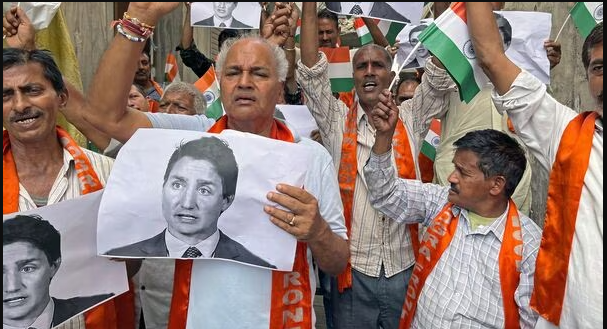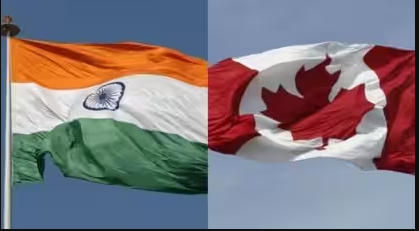The relationship between India and Canada reaches a new low when both nations expel diplomats over allegations involving the Khalistani terrorist Hardeep Singh Nijjar. Trade might not be affected.
India-Canada News
The relationship between the two countries has reached new lows as both have announced the expulsion of diplomatic personnel from the other. This comes after Canadian Prime Minister Justin Trudeau accused Indian government officials of involvement in the murder of Khalistani terrorist Hardeep Singh Nijjar.Following Canada’s expulsion of a senior Indian ambassador over the murder of Khalistani terrorist Hardeep Singh Nijjar, India on Tuesday requested that a senior Canadian diplomat leave the country, according to the Ministry of External Affairs. Asserting that Indian government agents killed Khalistan advocate Hardeep Singh Nijjar in June of this year, Canadian Prime Minister Justin Trudeau earlier today fired a senior Indian diplomat.
The ongoing anti-Indian activities of extremist elements in Canada that were encouraging secessionism, inciting violence against its diplomats, and endangering the Indian community there were conveyed by Prime Minister Narendra Modi to his Canadian counterpart Justin Trudeau on September 10, according to PTI.

Important trade information between India and Canada.
Canada is the 18th largest foreign investor in India, according to Invest India, with total investments of around $3,306 million between April 2000 and March 2023. So, of all the FDI (foreign direct investment) inflows into India, Canadian investment accounted for about 0.5%. In 2022, India ranked as Canada’s ninth-largest trading partner. Together, services and infrastructure accounted for 40.63% of all FDI investments made by Canada in India.Canada is the 18th largest foreign investor in India, according to Invest India, with total investments of around $3,306 million between April 2000 and March 2023. So, of all the FDI (foreign direct investment) inflows into India, Canadian investment accounted for about 0.5%. In 2022, India ranked as Canada’s ninth-largest trading partner. Together, services and infrastructure accounted for 40.63% of all FDI investments made by Canada in India.

On the other hand, India’s total imports from Canada in FY23 stood at $4,051.29 million which was nearly 0.6 per cent of India’s total imports of $714,042.45 million for the year, Ministry of Commerce data showed. According to a PTI report, India’s exports to Canada include pharmaceuticals, gems and jewellery, textiles, and machinery, while Canada’s exports to India include pulses, timber, pulp and paper, and mining products.
If we talk about personal remittances, in 2022, India received nearly $859.83 million in personal remittances from Canada, according to World Bank data.

India-Canada commerce may not be affected.
According to a PTI article, experts say that since economic ties between India and Canada are motivated by business interests, the recent escalation of hostilities is unlikely to have an effect on commerce or investments between the two nations.
Experts point out that because India and Canada trade in complimentary goods rather than comparable ones, these occurrences may not have an impact on their trade relations.
Ajay Srivastava, co-founder of the Global Trade Research Initiative (GTRI), was quoted by PTI as saying that Canadian pension funds will continue to invest in India due to the country’s sizable market and favourable return on investment.By the end of 2022, Canadian pension funds had made over $45 billion in investments in India, making it the fourth-largest beneficiary of FDI from Canada globally. Infrastructure, renewable energy, technology, and financial services are the top industries in India where Canadian pension funds are investing, according to a PTI report.

India and Canada Relations
The diplomatic relations between India and Canada have witnessed significant growth and diversification in recent years. Despite being geographically distant, these two nations have found common ground in various fields, fostering cooperation and mutual understanding. In this article, we will explore the historical context, key areas of collaboration, and the potential for even stronger ties between India and Canada.
Historical Perspective
India and Canada established diplomatic relations in 1947, following India’s independence. Since then, the relationship has evolved, with both nations contributing to each other’s development and progress. Canada has a substantial Indian diaspora, with people of Indian origin forming one of the largest visible minority groups in Canada. This cultural connection has played a significant role in strengthening people-to-people ties between the two countries.
Trade and Economic Relations
Trade between India and Canada has steadily grown over the years. Both countries have recognized the immense potential for economic cooperation. Canada is rich in natural resources, while India offers a vast consumer market. Bilateral trade agreements and investments in sectors such as agriculture, technology, and renewable energy have been driving economic growth in both nations. The Comprehensive Economic Partnership Agreement (CEPA) negotiations have further paved the way for expanding trade relations.
Education and Innovation
India and Canada have also collaborated extensively in the field of education and innovation. Many Indian students choose Canada for higher education, benefiting from its world-class universities and research opportunities. Joint research initiatives and academic exchanges have strengthened intellectual ties. Furthermore, India’s information technology industry has found a significant market in Canada, contributing to innovation and job creation.
Climate Change and Sustainability
Both countries are committed to addressing climate change and promoting sustainable development. They have cooperated on various environmental initiatives, including clean energy projects, renewable technologies, and climate adaptation strategies. By sharing knowledge and resources, India and Canada are working towards a more sustainable future.
Cultural Exchange and People-to-People Ties
Cultural exchange programs, festivals, and events have played a crucial role in enhancing mutual understanding. The Indian diaspora in Canada has contributed significantly to cultural diversity and has been a bridge for cultural exchange. These connections have helped create a rich tapestry of cultural appreciation between the two nations.
Challenges and Opportunities
While India and Canada have made substantial progress in their relationship, challenges such as trade barriers, visa issues, and intellectual property rights remain. These hurdles can be addressed through open dialogue and negotiation, allowing both nations to realize their full potential in their partnership.
Conclusion
India and Canada’s diplomatic relations have evolved into a multifaceted partnership, encompassing trade, education, culture, and sustainability. By addressing challenges and seizing opportunities, both nations can further strengthen their ties. As they work together, the future holds the promise of deeper cooperation and a brighter future for India and Canada, reflecting their shared values and aspirations on the global stage.
ALSO READ:The Diplomatic Pouch: Safeguarding Secrets And Building Bridges




































